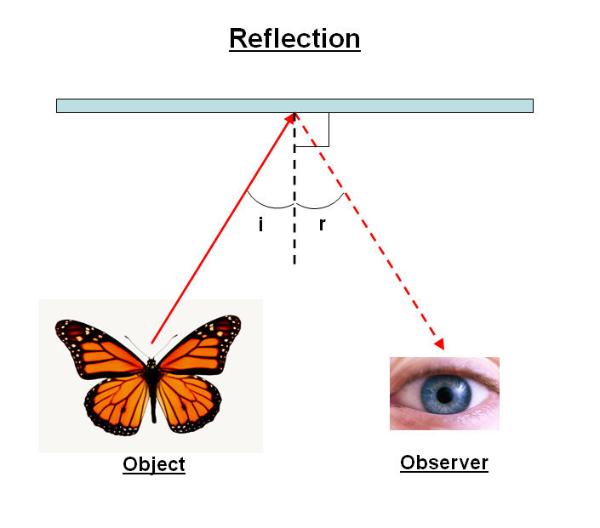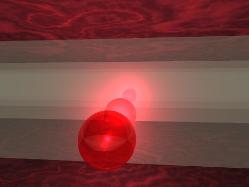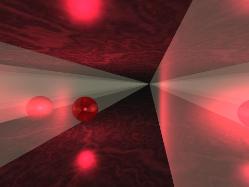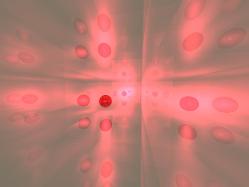Pov-Ray and some properties of light
What is refraction? Have you ever stood a pencil in a glass of water and noticed how the part of the pencil below the water looks
bent or displaced? This bending of light occurs whenever light crosses from one medium (such as air) into another (such as
water or glass) and is called refraction. Refraction occurs because the velocity of light in different media is different. For
example, light moves faster through air than it does through water. You may have heard it said that nothing travels faster than
light and that the speed of light is constant, well this refers to light in a vacuum - it is said that nothing can travel faster than light
in a vacuum. Well, this actually isn't true, correctly we should say that no signal can travel faster than light in a vacuum, though
many alien space travellers will disagree, but that's another story!
What is reflection? Waves, including light, are also subject to the pnenomenon of reflection. When rays of light reflect from a
surface they bounce off the surface at an angle equal and opposite to the angle that they strike the surface (the so-called angle
of incidence). In the diagram below, the image of a butterfly is reflected in a mirror and observed by an observer (the eye). If we
imagine a line (the black dashed line) called a normal which is at right-angles to the mirror, then the incoming light-ray from the
butterfly strikes the mirror at the angle of incidence 'i' with respects to the normal and reflects with the same angle of reflection 'r'
but in the opposite direction. Of course if i = zero, so that the light ray travels straight to the mirror, then it bounces straight back
to the object, these are the light-rays that you see when you look at your own reflection in a mirror - those rays with a low or zero
angle of incidence.
Simply a video of a glass cube rotating, but notice the interesting and realistic lighting effects that the
computer generated. Note that some light is transmitted and some is reflected.
computer generated. Note that some light is transmitted and some is reflected.
Below are some images of a glowing ball in a hall of mirrors - but which one is the real ball?
BotRejectsInc
At the moment I am looking into how to create realistic-looking laser beams with Pov-Ray, so stay-tuned for more updates!.
In reality, when light strikes an object like a glass ball, some of the light enters the glass and comes out at another point (the
light is transmitted by the glass) and so is refracted, and some of the light is reflected. Pov-Ray can easily simulate both
refraction and reflection in a glass sphere with any degree of opacity. A completely opaque sphere will transmit and so refract
no light, but may still reflect light if it is shiny. Some surfaces also absorb light, indeed most surfaces reflect and/or transmit
some colours of light, whilst absorbing others. A green leaf looks green because as white light (which is made up of all the
colours of light in the spectrum from red to blue) absorbs the red and blue light, but transmits and reflects the green (and some
of the yellow) light. Chemicals that selectively absorb only certain colours of light are called pigments. Click on the links below to
see some experiments with light conducted in Pov-Ray:
light is transmitted by the glass) and so is refracted, and some of the light is reflected. Pov-Ray can easily simulate both
refraction and reflection in a glass sphere with any degree of opacity. A completely opaque sphere will transmit and so refract
no light, but may still reflect light if it is shiny. Some surfaces also absorb light, indeed most surfaces reflect and/or transmit
some colours of light, whilst absorbing others. A green leaf looks green because as white light (which is made up of all the
colours of light in the spectrum from red to blue) absorbs the red and blue light, but transmits and reflects the green (and some
of the yellow) light. Chemicals that selectively absorb only certain colours of light are called pigments. Click on the links below to
see some experiments with light conducted in Pov-Ray:
In these examples, the sphere was made of red glass (glass pigmented red but not so as to make it completely opaque,
but rather translucent - transparent to certain colours only), that reflects and transmits mostly red light whilst absorbing
the other colours (blue, yellow and green, etc.). A white light was placed inside the sphere and so the sphere casts a red
reflection.
but rather translucent - transparent to certain colours only), that reflects and transmits mostly red light whilst absorbing
the other colours (blue, yellow and green, etc.). A white light was placed inside the sphere and so the sphere casts a red
reflection.



